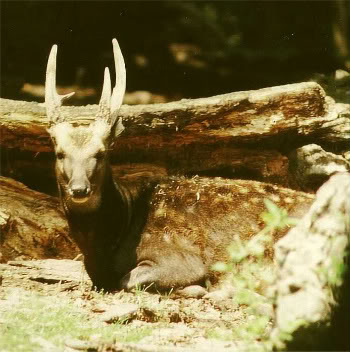A two week expedition into the North Negros Natural Park (NNNP) in the Philippines has led to several discoveries. In the 80,454 hectare park (nearly 200,000 acres), the expedition found what may be new species of insects and plants, in addition to a frog likely unknown to science. They also discovered evidence of the Visayan spotted deer, considered to be the world’s rarest deer and one of the rarest mammals. The team discovered droppings from the deer, which will be analyzed for food content.
For 10 years there has been no evidence of Visayan spotted deer still living in the wild, according to James Sawyer, one of the expedition members.
 The Visayan spotted deer in captivity at the Vienna Zoo. |
“We believe there are two distinct populations of the Visayan spotted deer in the NNNP interior. We covered only about one percent, which is great news,” he told Inquirer.net. Not recognized as a separate species until 1983, the deer is threatened by hunting and deforestation.
Another expedition member, Dr. Craig Turner described the park effusively to Inquirer.net: “this is definitely a unique environment—the center of this park has the most pristine rainforest we have ever seen anywhere in the world.”
While the team did not collect specimens, they hope to return within two years with a larger team of experts for an extended period of time to collect specimens and more thoroughly explore the park.
The expedition was carried out by Negros Forests and Ecological Foundation and Coral Cay Conservation.
Related articles
Palawan’s wildlife faces extinction risk due to mining, pet trade
(09/17/2008) Scientists warn that species on the Philippine island of Palawan are rapidly headed toward extinction due to habitat loss and the illegal wildlife trade. Last week ornithologist Aldrin Mallari presented a paper showing that all of Palawan’s endangered species inhabited lowland forest, according to an article in the Philippine Daily Inquirer. Lowland forest is broadly open to human development in Palawan, whereas areas above a thousand meters are protected.
Half of the Philippines’ endemic wildlife is with extinction
(07/22/2008) More than half the birds, amphibians and mammals endemic to the Philippines are threatened with extinction, according to a statement released by the country’s environment and natural resources department and reported by AFP.
Ecosystems in the Philippines bounce back from the brink
(03/19/2008) The Philippines has often been an example for the worst-case-scenario in environmental degradation. Some scientists have even concluded that environmental efforts should put elsewhere, claiming the Philippines to be a lost cause. In his book Requiem for Nature John Terborgh writes the “overpopulated… Philippines are already beyond the point of no return.” However, a recent paper entitled “Hope for Threatened Tropical Biodiversity: Lessons from the Philippines” argues that there are enough positive environmental and conservation trends in the Philippines to have hope and continue working for a better tomorrow.







